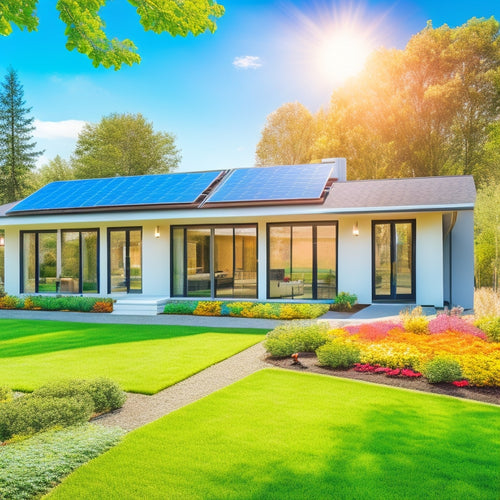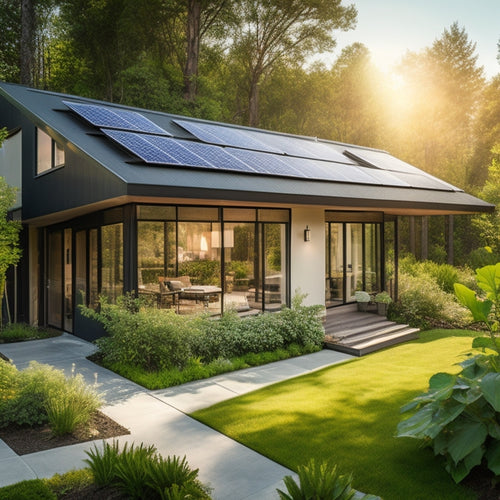
A 3-Step Guide to Residential Solar Panel Installation
Share
You'll first need to assess your solar readiness by conducting a site analysis to identify obstructions and evaluate your roof's condition and structural integrity. Next, you'll choose the right equipment, selecting high-efficiency solar panels and suitable inverters that can efficiently convert energy. Finally, you'll select a qualified installer who's knowledgeable about local regulations and has a proven track record of successful installations. By following these three essential steps, you'll be well on your way to utilizing the power of the sun - and there's still more to investigate in the process ahead.
Key Takeaways
- Assess your home's solar readiness by conducting a site analysis, evaluating energy needs, and ensuring regulatory compliance.
- Choose the right equipment, including high-efficiency solar panels, suitable inverters, and additional components like battery storage.
- Select a qualified installer with necessary licenses, certifications, and experience to ensure a successful installation.
- Properly prepare the site before installation, including assessing roof orientation and shading, and preparing surrounding areas.
- Ensure a smooth installation process by following a step-by-step guide, including mounting and connecting panels, inverter setup, and net metering.
Assessing Your Solar Readiness
Your roof, a prime piece of real estate, is about to become a power-generating hub. To reveal the full solar energy benefits, you'll need to evaluate your solar readiness. This involves a thorough site shading analysis to identify any obstructions that might impact energy production.
A roof condition assessment is also essential to confirm your roof can support the weight of the solar panels.
Next, an energy consumption analysis will help determine your energy needs and identify opportunities for energy efficiency improvements. Orientation enhancement is key to maximizing energy production, so your solar panels will be strategically placed to capture the most sunlight.
Local climate impact and zoning regulations will also be considered to guarantee compliance and peak performance.
Based on these factors, a system size calculation will be performed to determine the ideal system size for your property. An installation timeline will be provided, outlining the steps and milestones involved in the installation process.
Choosing the Right Equipment
Optimization is key when it comes to utilizing the full potential of solar energy. When choosing the right equipment for your residential solar panel installation, you'll need to take into account several factors to guarantee maximum energy output.
First, you'll need to decide on the type of solar panels that best suit your energy needs. There are two primary solar panel types: monocrystalline and polycrystalline. Monocrystalline panels are more efficient, but also more expensive. Polycrystalline panels, on the other hand, offer a lower upfront cost but slightly lower efficiency ratings.
Efficiency ratings are essential in determining how much energy your system can produce. Look for panels with high efficiency ratings (above 20%) to maximize your energy output.
Additionally, think about the inverter type, as it affects the system's overall efficiency. String inverters are the most common, but microinverters and power optimizers offer more flexibility and monitoring capabilities.
Understanding Local Incentives
Government initiatives and local policies play a crucial role in encouraging the adoption of renewable energy sources, including solar power. As you consider installing solar panels, you'll want to understand the local incentives that can help offset the upfront cost.
You may be eligible for local tax incentives, state rebates, or federal credits that can greatly reduce your investment. Additionally, community programs and renewable energy certificates can provide further financial benefits. You may also have access to financing options or grant opportunities to help you get started.
These incentives not only reduce the financial burden but also increase your property value. By investing in solar power, you're not only contributing to energy independence but also reaping environmental benefits.
It's important to research and take advantage of these incentives to maximize your return on investment. By doing so, you'll be able to enjoy the benefits of solar power while minimizing the costs.
Selecting a Qualified Installer
You'll want to verify your chosen installer holds the necessary licenses and certifications, such as a North American Board of Certified Energy Practitioners (NABCEP) certification, to assure a safe and efficient installation.
Additionally, you should evaluate their experience and proficiency in installing solar panels, including the number of successful projects they've completed and their familiarity with local building codes.
Licenses and Certifications
When selecting a qualified installer for your residential solar panel installation, it's crucial to scrutinize their licenses and certifications, as these credentials directly impact the quality of their work and, ultimately, the performance of your solar panel system.
You want an installer who holds a valid electrical contractor's license, as this guarantees they're qualified to perform electrical work. Additionally, look for certifications from reputable organizations like the North American Board of Certified Energy Practitioners (NABCEP). This certification indicates the installer has passed a rigorous exam and has the necessary knowledge to design and install solar panel systems that meet industry standards.
During the permitting process, your installer should be well-versed in regulatory compliance, making certain your system meets local building codes and permitting requirements. They should also be familiar with local and national electrical codes, such as the National Electric Code (NEC).
Experience and Expertise
Beyond licenses and certifications, a qualified installer's experience and knowledge play an essential role in ensuring a successful residential solar panel installation. You want an installer who stays up-to-date with the latest solar industry trends and installation best practices to maximize your system's performance and efficiency.
Look for an installer with a proven track record of customer satisfaction, as this indicates their ability to effectively communicate and meet your needs. A qualified installer should also be able to explain the environmental impact and financial benefits of your solar panel system, as well as address any common misconceptions you may have.
Be wary of DIY installations, as they often compromise on solar panel efficiency and may not integrate seamlessly with your existing renewable energy infrastructure. Instead, opt for an installer who utilizes technology advancements to optimize your system's performance.
Pre-Installation Site Preparation
How prepared is your property for a seamless residential solar panel installation?
Before the installation process begins, it's crucial to evaluate your property's readiness. This phase is critical in guaranteeing a smooth and successful installation.
To determine your property's suitability, consider the following factors:
-
Roof Orientation and Shading Analysis: Assess the orientation of your roof and potential shading from trees, buildings, or other obstructions to guarantee maximum energy production.
-
Structural Integrity: Evaluate the condition of your roof to confirm it can support the weight of the solar panels and withstand environmental factors.
-
Local Regulations and Compliance: Verify that your installation meets local building codes, permits, and regulations.
- Site Accessibility and Energy Consumption: Assess the accessibility of your roof and surrounding areas, as well as your energy consumption patterns, to determine the ideal system size and design.
Mounting and Connecting Panels
You'll need to choose the right panel mounting option for your residential solar installation, considering factors like roof type, size, and local building codes.
Next, you'll secure the panels using connection methods that guarantee a watertight seal and withstand environmental stresses.
Panel Mounting Options
Mounting and connecting solar panels marks a vital phase in your residential solar panel installation, as it directly impacts the system's performance, durability, and overall safety.
When determining the ideal panel mounting option for your system, you'll need to take into account several key factors.
- Roof-mounted systems: Suitable for most roof types, these systems require careful assessment of your roof's structural integrity and potential shading issues.
Tilt angles and installation techniques must be refined to guarantee maximum energy output.
- Ground-mounted systems: Ideal for larger properties, these systems employ ground mounts and can be paired with solar trackers to enhance energy production.
Aesthetic considerations and material choices are significant to guarantee a visually appealing and durable installation.
- Solar trackers: These advanced systems adjust the panel's angle to follow the sun's movement, increasing energy output by up to 45%.
However, they require careful evaluation of cost implications and durability factors.
- Custom solutions: In some cases, a custom mounting solution may be necessary to accommodate unique roof geometries or shading patterns.
A thorough shading analysis and expert installation techniques are essential to guarantee peak performance and safety.
Secure Connection Methods
A well-designed connection method is the backbone of a reliable solar panel installation, as it guarantees the secure fastening of panels to the mounting structure and facilitates efficient energy transmission.
You'll want to confirm that your connection method meets or exceeds industry safety standards to prevent electrical shock, fires, or other hazards.
When connecting your solar panels, you'll need to select suitable wiring techniques that accommodate the electrical currents and voltages generated by your system.
You should consider using weather-tight connectors and UV-resistant wiring to withstand outdoor exposure. Additionally, make certain to label and organize your wiring to facilitate easy maintenance and troubleshooting.
It's essential to verify that your connection method complies with local building codes and electrical regulations.
You may want to consult with a licensed electrician or solar panel professional to confirm your installation meets the necessary safety standards.
Inverter and Electrical Setup
As you venture into the inverter and electrical setup, configure your system to guarantee seamless energy conversion and transmission. This critical stage guarantees your solar panel system efficiently generates and distributes power to your home.
Choose the right inverter type for your system, considering factors like efficiency, cost, and compatibility. You'll need to decide between string inverters, microinverters, or power optimizers, each with its advantages and disadvantages.
Prioritize electrical safety by:
- Confirming all electrical connections meet local building codes and standards
- Installing a grounded fault protection device to prevent electrical shocks
- Using surge protectors to safeguard your system from power surges and spikes
- Implementing a monitoring system to track your energy production and detect potential issues
Net Metering and Inspections
With your inverter and electrical setup in place, you're ready to tackle the crucial step of net metering and inspections. Net metering benefits include offsetting your energy consumption, reducing your utility bills, and potentially generating revenue through excess energy production.
To guarantee a smooth and successful installation, you'll need to meet the inspection requirements set by your local authorities and utility company. These requirements typically include:
| Inspection Requirements | Description | Responsible Party |
|---|---|---|
| Electrical Inspection | Verify electrical connections and compliance with local codes | Licensed Electrician |
| Roof Inspection | Confirm the roof is structurally sound and can support the solar panels | Licensed Roofer/Structural Engineer |
| Net Metering Approval | Approve the net metering setup and connection to the grid | Utility Company |
Activating Your Solar System
Your solar panel installation is nearing completion, and you're enthusiastic to start generating clean energy and reducing your utility bills.
Now it's time to activate your solar system and start utilizing the power of the sun.
To guarantee a smooth solar system activation, follow these essential steps:
-
Verify system connections: Double-check that all electrical connections are secure and meet the manufacturer's specifications to avoid any safety hazards or system malfunctions.
-
Initialize the inverter: Follow the manufacturer's instructions to initialize the inverter, which converts DC power from the solar panels to AC power for your home.
-
Monitor system performance: Keep an eye on your system's performance using a monitoring platform or app to identify any issues or potential problems.
- Perform initial troubleshooting: Be prepared to identify and address common issues, such as inverter errors or panel misalignment, using troubleshooting tips provided by your installation company or manufacturer.
Ongoing System Maintenance
Twenty-five years or more of reliable solar energy production rely on one essential factor: ongoing system maintenance.
You'll want to make certain your system operates at peak levels to maximize energy efficiency and reduce your reliance on the grid. Regular solar panel cleaning is vital to maintain peak performance, as dirt and debris can reduce energy output by up to 25%.
You'll also need to monitor your system's performance regularly to identify any issues promptly. This includes tracking your energy production, consumption, and storage, especially if you have battery storage.
Inverter maintenance is essential, as it converts DC power from your panels to AC power for your home. Keep an eye out for warranty coverage, and schedule system upgrades as needed to guarantee you're getting the most out of your investment.
Be prepared to troubleshoot issues, such as weather-related problems or grid connection faults. By staying on top of maintenance, you'll enjoy reliable, efficient, and clean energy for years to come.
Frequently Asked Questions
Can I Install Solar Panels on a Rented Property?
You're wondering if you can install solar panels on a rented property. Look into a solar lease, which allows you to utilize the power without owning the system. Research your tenant rights to guarantee you're protected.
Are Solar Panels Affected by Hail or Extreme Weather?
As you capture the sun's fiery power, you wonder if hail's icy grip or torrential rains will shatter your solar dreams. Rest assured, you'll find that quality solar panels are built to withstand hail damage and extreme weather, boasting weather resistance that's as tough as your commitment to renewable energy.
Can I Sell Excess Energy Back to the Grid?
You can sell excess energy back to the grid through net metering benefits, which allow you to offset your consumption and potentially receive credits or even cash through energy buyback options, depending on your utility company's policies.
Will Solar Panels Increase My Property's Value?
Like a diamond in the rough, your property's value will shine brighter with solar panels, as a property appraisal will reflect increased value due to energy savings, making your home a hot commodity on the market, and you'll reap the benefits.
Are Solar Panels Compatible With Clay or Metal Roofs?
You'll find solar panels compatible with clay or metal roofs, thanks to adaptable installation methods that cater to various roof materials, ensuring a secure and efficient setup that utilizes maximum power for your home.
Conclusion
As you flip the switch, the meter starts spinning backwards - a sweet sight! Your residential solar panel system is now live, generating clean energy and savings. But the expedition doesn't end here. Ongoing maintenance is key to peak performance. Stay vigilant, monitoring your system's health and addressing any issues promptly. The sun shines bright, and so does your future - powered by renewable energy and a wise investment.
Related Posts
-

Off-Grid Solar Solutions for Sustainable Farming
Off-grid solar solutions can revolutionize your farming operations by providing energy independence and significant c...
-

How Solar Panels Increase Property Value
Installing solar panels considerably increases your property value by improving energy efficiency and attracting eco-...
-

Integrating Solar Panels Into Home Design
Integrating solar panels into your home design greatly enhances energy efficiency and lowers utility bills while addi...


